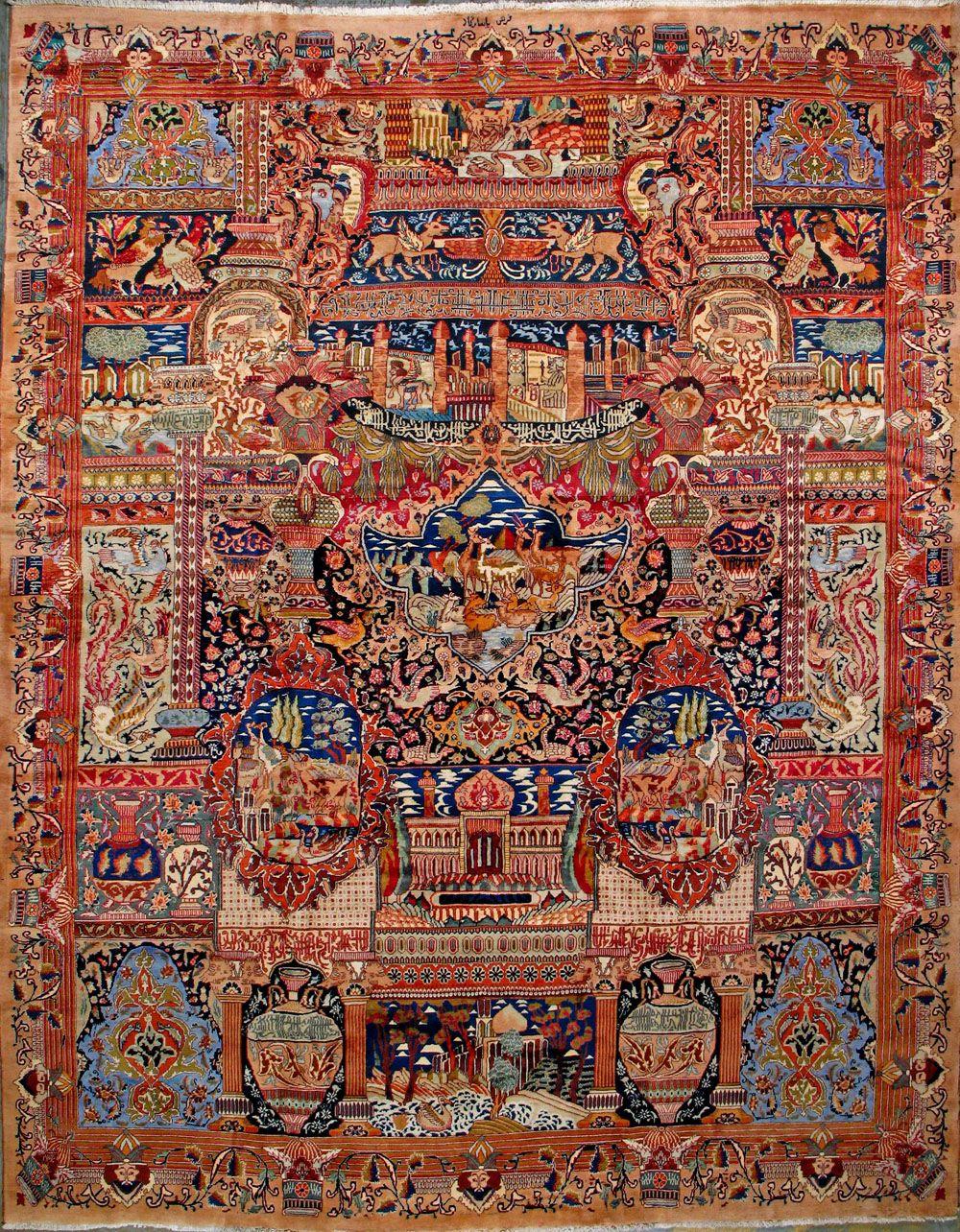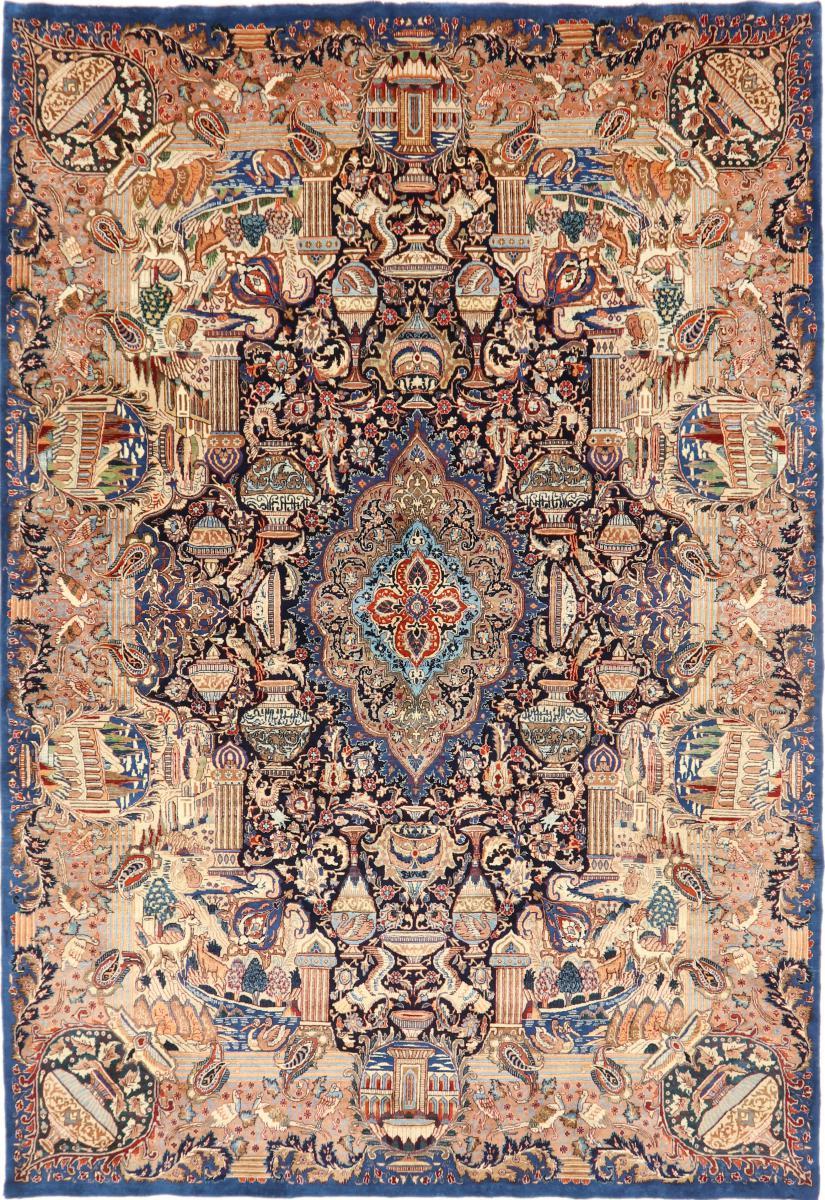Introduction of handmade cashmere carpet
Kashmar is one of the most important carpet weaving areas of Greater Khorasan province. The carpet of this area is among the most expensive carpets in the market due to its quality in texture and raw materials, its elegance and thinness. Currently, there are many carpet weaving workshops in Kashmar and its surrounding areas, and many people are engaged in carpet weaving professionally and with commercial purposes in this city. In this article, we intend to introduce you to the features and characteristics of hand-woven cashmere carpets.
Historical and geographical features of Kashmar
Kashmar is one of the western cities of Khorasan province. Its previous name was Tarshiz, which geographers recorded as Tarshish and later Tarshish and Tarshis. In the past, Tarshiz was part of a province called Bushet (Posht), and other than Tarshiz, another famous city was called Kandar. Moghdisi gave a detailed description of Tarshiz Jami Mosque and in his opinion, apart from Damascus Jami Mosque, no other Jami Mosque could be equal to it. According to Ibn Athir, in 520 AH, Sultan Sanjar Seljuqi besieged Tarshiz, and from then on, the city became one of the important centers of Ismailia. The ruler of this region asked for help from the Turks to prevent the influence and against Ismailia. But instead of helping, the Turks looted and destroyed the city. After the destruction of Ismailia by Holakukhan, Tarshiz turned to Abadani once again. In the 8th century AH, Amir Timur Gurkani captured it and then destroyed it. This event took place in 783 AH and after that the name of Tarshiz disappeared from the map. This city is limited to Sabzevar and Neishabur from the north, Torbat Heydarieh from the east, Gonabad, Firdos and Tabas from the south, and Shahroud from the west. Kashmar is about 230 kilometers away from the capital of Razavi Khorasan province (Mashhad).
Records of carpet weaving in Kashmar
According to the researches, the history of contemporary carpets in this city goes back to the years before 1300 AH. According to the traditions and sayings of the old people of Kashmar, the beginning of the weaving era in Kashmar should be searched for between 1260 and 1280 AH. Mohammad Kermani was the first master carpet weaver in the Kashmar region, and according to his name, it seems that he was a resident of Kerman who migrated to Kashmar. Some people believe that his birthplace is the village of Furutagha, 2 kilometers east of Kashmar, and that he learned this art in Kerman and from Kermani masters. However, there is little doubt that the beginning and expansion of carpet weaving in Kashmar started from the village of Farutagha between 1260 and 1280 AH, and there is no doubt that this art started and spread to other nearby villages from here. For the first time, this master craftsman started to weave carpets, probably at the request of Haj Seyed Hossein Sajjadi, from the people of Farutqa. After that, due to the acceptance of the people of the village, this art gradually spread, and after the collapse of the villages of Torbeghan, Fadafan, Kazhkhane, and Rizk Abad, one after the other, they followed it and began weaving carpets.
The most important carpet weaving centers around Kashmar
The villages of Farutagha, Kazhkhane, Fadafan, Farag, Torbeghan, Rizk Abad, as well as Khalil Abad and Bardeskan, along with their surrounding villages, are among the most important carpet weaving areas in the outskirts of Kashmar.

Appearance characteristics of cashmere carpet
- Design: Currently, Kashmari weavers often use various traditional and original designs of Iranian carpets such as Zizkhaki, Afshan Shah Abbasi, Mashhad-style lakh and tranj, Nayin designs, Kashan and Golfarang styles, as well as pictorial designs. . Carpet weaving with a similar design to Nayin is one of the most common types of carpet weaving in Kashmar. But we must mention that the Nain carpet woven in Kashmar never has the quality of the original Nain carpet. Also, until about 30 years ago, clay motifs in the style of Bakhtiari carpets were sporadically seen in Kashmar carpets, whose production has now been completely stopped. It seems that this pattern was always woven in the western regions of Kashmar by the survivors of the Bakhtiari tribes who had moved to the western regions of Kashmar since the time of Nadir Shah Afshar. Carpet texture with patterns similar to the famous Lakh and Taranj of Kashan is also popular in Kashmar. In this case too, Kashmar weavers try to make the color of the carpet similar to the original examples of Kashan. This design is one of the best-selling cashmere designs, next to Lach and Tangerine. The underground pattern is one of the common motifs in cashmere carpets, which, due to its quality and originality, is considered among the antique and collectible carpets. In underground carpets, the image of vases, jars and generally antique objects are used. The use of creative and attractive motifs and symbols has turned the underground design into one of the most popular and beloved designs in Kashmar and Iran. The most interesting feature of the underground design of the handmade cashmere carpet is the three-dimensionality of some motifs and symbols on the border of these carpets, which has given this design an exemplary beauty and charm.
- Color: The lacquer color used in cashmere carpet is one of its distinguishing features, which is generally bright and known as gol khari lacquer. In fact, cashmere carpet can be recognized in the market by its unique lacquered color. In imitation designs from other regions such as Nayin, mostly the types of colors match the carpets of those regions. Other common colors in cashmere carpets include blue, navy, green and cream. It is common to use both natural and ink dyes in dyeing the fibers of cashmere carpets. In fact, one of the other characteristics of cashmere carpet is the wide use of ink colors.
- Dimensions: the most important dimensions of cashmere rugs are 3 x 2 and 5.3 x 5.2 square meters and sometimes larger, but small dimensions such as padari, kenareh, Kalegi, etc. are generally not considered by cashmere weavers.
- Raw materials used: Raw materials, in cashmere carpets, cotton thread is always used for the warp and weft, and wool for the pile. Only very limited use of silk is used in similar woven carpets of Nayin designs. Otherwise, the pile of cashmere carpets is always made of wool. It is interesting to mention that Kashmar is one of the largest cotton producing areas in Iran. Also, in many cases, the wool used in carpet weaving is obtained from the local livestock of this region. Therefore, due to the use of local raw materials, cashmere carpets are always of high quality.
Technical characteristics of tissue
- Knot type: The type of knot used in Kashmar is both Turkish and Persian knots, but Persian knots are more common. Handwoven cashmere carpets are considered thin and light in weight. This factor, along with the quality of raw materials, has made cashmere carpets among the relatively expensive carpets in the market.
- Rajshmar: The Rajshmar of cashmere carpet is medium and generally between 30 and maximum 40 rows. But the old samples are slightly coarser. In fact, this index is equivalent to about 600 to 900 knots per square inch. Therefore, cashmere carpets are in the middle category in terms of the fineness of the texture; It means that they are neither very fine weave nor coarse weave.
- Shirazeh weaving: almost all cashmere carpets now have separate shirazeh. That is, after finishing weaving and taking it down from the hanger, the edges of both sides of Shirazeh carpet are twisted.
- How to pay: Currently, most cashmere rugs are paid after the weaving is finished. For this purpose, today, large scissors that work with electric power are used.
- Type of dars: Most carpet weaving dars in Kashmar are vertical and fixed. The material of the doors was especially made of wood in the past; But metal fences have been used in this area for several years. Farsh Iran Joint Stock Company has played an important role in replacing the wooden frames of this region with its metal type.
- Challekshi: Most of the cashmere carpets today are drawn in the famous Turkish style, that is, on a dar.
- Wefting method: Cashmere carpets are all woven in two wefts (two thin and thick wefts) and often tend to be in a loop weave style. Cotton fibers are used for the weft in the carpets of this region.
- Carpet weaving: all cashmere carpets have carpet weaving in Persian style.
Carpet designers and producers
In Kashmar, Azizullah Khani, Ahmad Turk, Haj Abbas Golestani, Mohammad Hossein Wazan, Gholamreza Abedini, Mohammad Mushtaqi and Ali Asghar Musafir were and are the most important producers of Kashmar carpets in the last 70 years. Ostad Alipour, Ostad Gholamhossein Eskandari Tarbqani, Ali Akbar Jafari, Javad Javadi, Mohammad Eskandari, Maroufi and Talati are among the ancient and modern designers of Kashmar.
The price of handmade cashmere carpet
In general, the price of hand-woven carpets depends on various factors such as dimensions, quality of texture and raw materials, fineness of texture and pattern. But in general, it should be said that hand-woven cashmere carpets are in the category of hand-woven carpets with a relatively high price.
You can inquire about Buying Handwoven Carpets , Buying Handwoven Kilim and Mats , and Buying Handwoven Pictorial Rug Tableaus online from the Hoveida Carpet Store and register all your orders and Wherever you are in the world, deliver it to the desired address in less than 4 working days.
If you are interested in reading other articles in the field of Handwoven carpets or Handwoven Pictorial Rug Tableaus , please refer to Hoveida Carpet Commercial
Leave a comment
Your email address will not be published. Required fields are marked *












